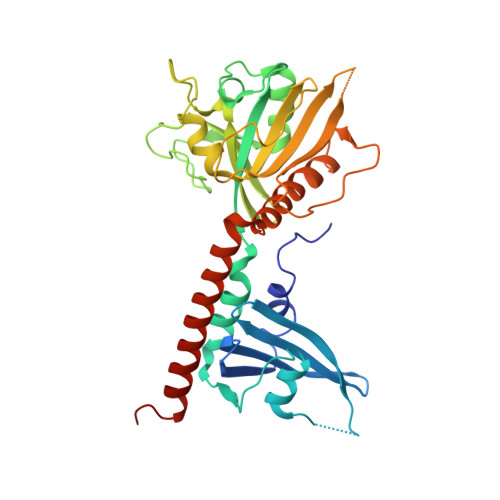The GTPase activating protein Rap1GAP uses a catalytic asparagine
Daumke, O., Weyand, M., Chakrabarti, P.P., Vetter, I.R., Wittinghofer, A.(2004) Nature 429: 197-201
- PubMed: 15141215
- DOI: https://doi.org/10.1038/nature02505
- Primary Citation of Related Structures:
1SRQ - PubMed Abstract:
Rap1 is a Ras-like guanine-nucleotide-binding protein (GNBP) that is involved in a variety of signal-transduction processes. It regulates integrin-mediated cell adhesion and might activate extracellular signal-regulated kinase. Like other Ras-like GNBPs, Rap1 is regulated by guanine-nucleotide-exchange factors (GEFs) and GTPase-activating proteins (GAPs). These GAPs increase the slow intrinsic GTPase reaction of Ras-like GNBPs by many orders of magnitude and allow tight regulation of signalling. The activation mechanism involves stabilization of the catalytic glutamine of the GNBP and, in most cases, the insertion of a catalytic arginine of GAP into the active site. Rap1 is a close homologue of Ras but does not possess the catalytic glutamine essential for GTP hydrolysis in all other Ras-like and Galpha proteins. Furthermore, RapGAPs are not related to other GAPs and apparently do not use a catalytic arginine residue. Here we present the crystal structure of the catalytic domain of the Rap1-specific Rap1GAP at 2.9 A. By mutational analysis, fluorescence titration and stopped-flow kinetic assay, we demonstrate that Rap1GAP provides a catalytic asparagine to stimulate GTP hydrolysis. Implications for the disease tuberous sclerosis are discussed.
- Max-Planck-Institut für Molekulare Physiologie, Otto-Hahnstr. 11, 44227 Dortmund, Germany.
Organizational Affiliation:


















